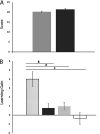Discussion of Annotated Research Articles Results in Increases in Scientific Literacy within a Cell Biology Course
- PMID: 37089223
- PMCID: PMC10117138
- DOI: 10.1128/jmbe.00154-22
Discussion of Annotated Research Articles Results in Increases in Scientific Literacy within a Cell Biology Course
Abstract
As the amount and complexity of scientific knowledge continues to grow, it is essential to educate scientifically literate citizens who can comprehend the process of science and the implications of technological advances. This is especially important when educating science, technology, engineering, and mathematics (STEM) college students, since they may play a central role in the future of scientific research and its communication. A central part of decoding and interpreting scientific information is the ability to analyze scientific research articles. For this reason, many different approaches for reading scientific research articles have been developed and published. Despite the availability of numerous ways of analyzing scientific research articles, biology students can face challenges that may prevent them from fully comprehending the text. We sought to address student challenges with science vocabulary and content knowledge by adding structural supports to in-classroom article discussions through the use of annotated articles from the Science in the Classroom initiative. We describe the pedagogical approach used for discussing scientific research articles within a required biology course. In this context, we found that students' scientific literacy skills increased at the end of the semester. We also found that, for each article discussed, the majority of students could interpret graphical representations of article results and that they could identify and comprehend components of the experimental design of the study.
Keywords: STEM education; data interpretation; experimental design; primary literature; process of science; research articles; scientific literacy.
Copyright © 2023 Washburn et al.
Conflict of interest statement
The authors declare no conflict of interest.
Figures



References
-
- Miller JD. 2004. Public understanding of, and attitudes toward, scientific research: what we know and what we need to know. Public Underst Sci 13:273–294. doi:10.1177/0963662504044908. - DOI
-
- Koeppen K, Hartig J, Klieme E, Leutner D. 2008. Current issues in competence modeling and assessment. Zeitschr Für Psychol 216:61–73. doi:10.1027/0044-3409.216.2.61. - DOI
-
- OECD. 2017. PISA 2015 assessment and analytical framework: science, reading, mathematic, financial literacy and collaborative problem solving. OECD Publishing, Paris, France. doi:10.1787/9789264281820-en. - DOI
LinkOut - more resources
Full Text Sources
Research Materials
